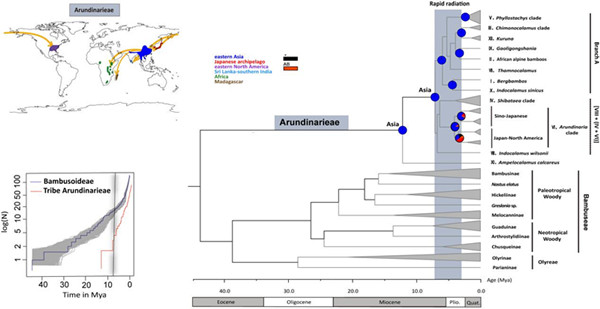Molecular Phylogenetics and Evolution:昆明植物所深入探讨了温带木本竹
近日,国际著名进化生物学期刊《molecular Phylogenetics and evolution》 杂志在线发表了以“Multi-locus plastid phylogenetic biogeography supports the Asian hypothesis of the temperate woody bamboos (Poaceae: Bambusoideae”为题的论文,对于深入探讨气候变化对植物多样性的影响和温带木本竹子的时空多样化格局具有重要意义。
温带木本竹子分支(即竹亚科青篱竹族)是亚高山寒温带针叶林的重要成分,包括了我国最重要的经济竹种——毛竹,也包括了大熊猫在其自然栖息地取食的全部竹种,特别是箭竹类。这一重要的竹子家族于何时何地起源、演化,又如何形成现今的东亚—北美、以及东亚—南亚—非洲间断分布格局?这些问题一直存在争论:亚洲起源假说或亚洲外起源假说。
最近,中国科学院昆明植物研究所研究员李德铢和郭振华领导的研究团队通过国际合作,基于广泛取样、多个叶绿体片段的数据和化石证据开展了温带木本竹子的分子生物地理学研究,深入探讨了该类群的地理起源与演化。该研究团体通过选取涵盖青篱竹族全部12个分支及其现代分布区的28属75种79个个体,以及热带木本竹子分支(即箣竹族)6个亚族24属45种46个个体和草本分支(即莪利竹族)2个亚族5属5种5个个体,测定了每个个体6个叶绿体dna片段的数据,据此开展系统发育生物地理学分析。结果支持竹亚科内部三个族为很好的单系;在青篱竹族12个分支中,第XI分支 (贵州悬竹Ampelocalamus calcareus) 最早分化;紧接着出现两大支,一支包含IV (Shibataea clade)、VI (Arundinaria clade) 和VIII (Indocalamus wilsonii)三个分支,另一支由其余8个分支 (I、II、III、V、VII、IX、X、XII) 构成。首次发现第XII分支(即斯里兰卡分支Kuruna)与东亚的第III分支 (Chimonocalamus clade) 为姐妹群。非洲两个支系I (Bergbambos) 和II (African alpine bamboos) 不聚为单系,分别与东亚的类群近缘。
通过化石校正和分子钟分析显示,竹亚科在晚始新世 (约43-47 Myr) 开始分化。青篱竹族是很年轻的一个族,最初在中新世中期 (约13-14 Myr)开始分化,随后在中新世晚期 (约7-8 Myr) 发生了快速辐射,在大约4百万年内产生了11个主要支系 (特别是包括了毛竹和箭竹类在内的IV、V和VI等分支)。古气候研究学者均认为东亚季风在晚中新世发生过显著增强,该一事件很可能促使了青篱竹族在东亚地区的快速多样化。进一步的祖先分布区重建表明,青篱竹族的最近的祖先分布在东亚地区,中国特有的贵州悬竹(第XI分支) 是青篱竹族的基部类群。该研究排除了斯里兰卡和非洲温带竹子位于基部的假设,支持青篱竹族的亚洲起源假说(Asian hypothesis)。研究表明,在上新世至少发生过两次亚洲到非洲的扩散事件,是青篱竹族亚洲和非洲间断分布形成的可能过程;上新世早期,从东亚经白令陆桥迁移到北美,导致青篱竹族东亚和北美间断分布格局的形成。

温带木本竹子分支的祖先分布区重建,显示中新世晚期以来的快速辐射进化
原文链接:
原文摘要:
In this paper we investigate the biogeography of the temperate woody bamboos (Arundinarieae) using a densely-sampled phylogenetic tree of Bambusoideae based on six plastid DNA loci, which corroborates the previously discovered 12 lineages (I–XII) and places Kuruna as sister to the Chimonocalamus clade. Biogeographic analyses revealed that the Arundinarieae diversified from an estimated 12 to 14 Mya, and this was followed by rapid radiation within the lineages, particularly lineages IV, V and VI, starting from c.7–8 Mya. It is suggested that the late Miocene intensification of East Asian monsoon may have contributed to this burst of diversification. The possibilities of the extant Sri Lankan and African temperate bamboo lineages representing ‘basal elements’ could be excluded, indicating that there is no evidence to support the Indian or African route for migration of temperate bamboo ancestors to Asia. Radiations from eastern Asia to Africa, Sri Lanka, and to North America all are likely to have occurred during the Pliocene, to form the disjunct distribution of Arundinarieae we observe today. The two African lineages are inferred as being derived independently from Asian ancestors, either by overland migrations or long-distance dispersals. Beringian migration may explain the eastern Asian–eastern North American disjunction.
doi:10.1016/j.ympev.2015.11.025
作者:张先志

